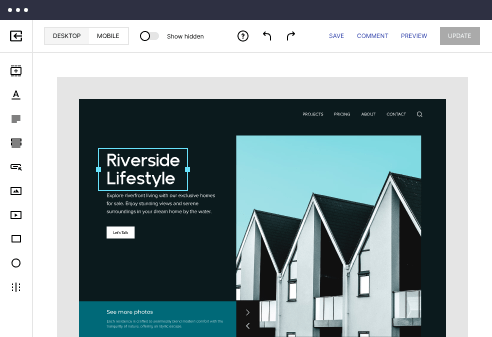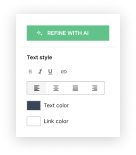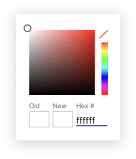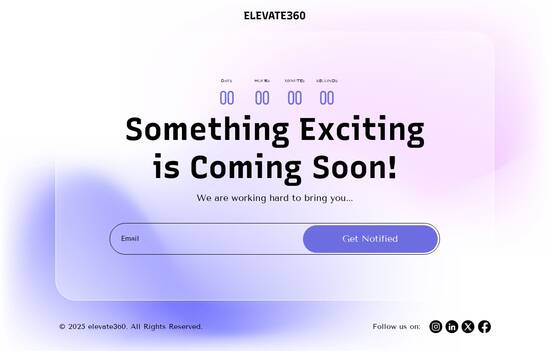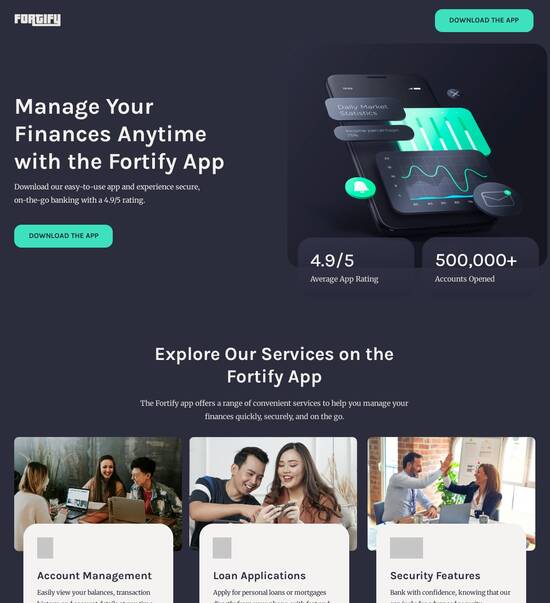
Pitch page template for video game companies
Explore Similar TemplatesAbout template
Reach out to the right audience with pitch page template for video game companies
Recommended templates
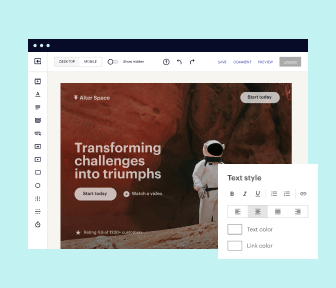
Easy to build without coding
With the intuitive drag-and-drop builder, anyone on your team can create high-converting pages without any knowledge of code or design. Make enhancements to your landing page with custom widgets using Javascript, HTML/CSS, or third-party scripts.
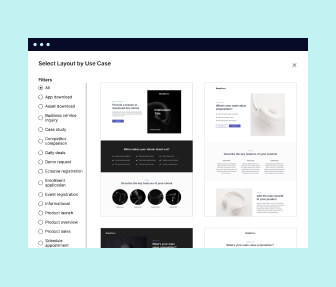
Multiple layouts for any industry and goal
Select from 500+ landing page layouts built to boost conversions across industry-specific scenarios. Customize them by adjusting fonts, adding images, and generating on-brand content with the AI assistant. Quickly scale with Instablocks® and Global Blocks that you can save, reuse, and update globally.
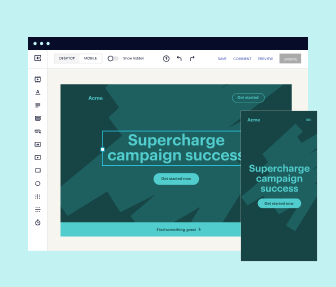
Loads fast and looks polished on any device
Every template is responsive, which means they present professionally on any device and load blazingly fast with our Thor Render Engine. You can also power them up with Google AMP technology to deliver an unparalleled mobile experience and drive higher conversions.
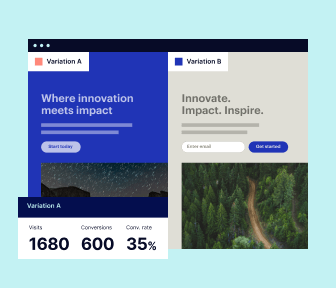
Robust analytics & experimentation
Get real-time updates and reporting across all your devices, showing the number of visitors, conversions, cost-per-visitor, and cost-per-lead. Launch AI-powered experiments, run A/B tests, and use heatmaps to analyze user behavior, then optimize your landing page to maximize conversions.
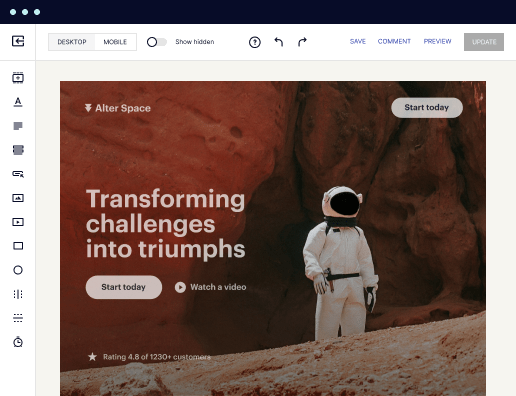
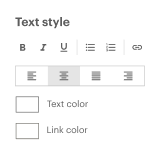
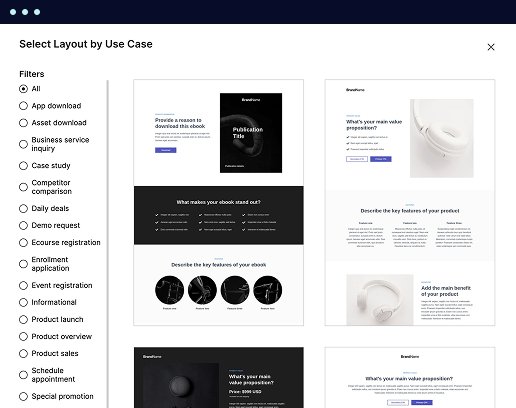
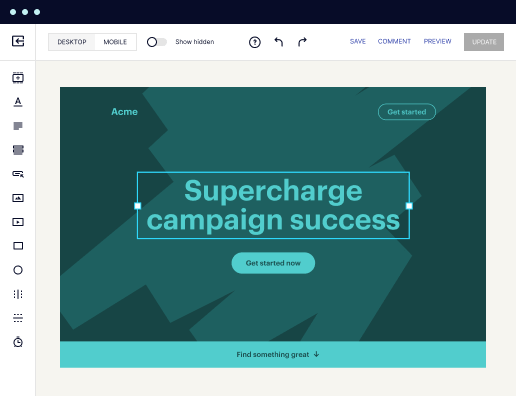
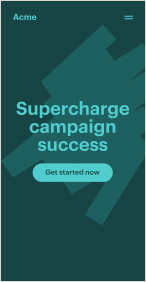
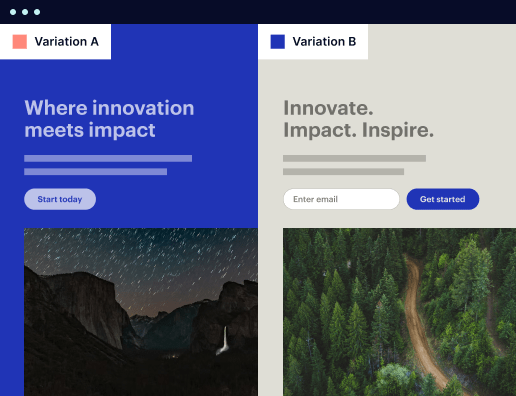
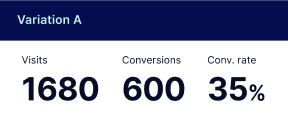
Easy to build without coding
With the intuitive drag-and-drop builder, anyone on your team can create high-converting pages without any knowledge of code or design. Make enhancements to your landing page with custom widgets using Javascript, HTML/CSS, or third-party scripts.
Multiple layouts for any industry and goal
Select from 500+ landing page layouts built to boost conversions across industry-specific scenarios. Customize them by adjusting fonts, adding images, and generating on-brand content with the AI assistant. Quickly scale with Instablocks® and Global Blocks that you can save, reuse, and update globally.
Loads fast and looks polished on any device
Every template is responsive, which means they present professionally on any device and load blazingly fast with our Thor Render Engine.
Robust analytics & experimentation
Get real-time updates and reporting across all your devices, showing the number of visitors, conversions, cost-per-visitor, and cost-per-lead. Launch AI-powered experiments, run A/B tests, and use heatmaps to analyze user behavior, then optimize your landing page to maximize conversions.
All the features you need to build lead-generating landing pages
Explore more featuresLearn how to build top-performing landing pages for any goal
FAQs
Leading the way in building high-performing landing pages





A comprehensive guide to using Instapage for effective digital marketing campaigns
Instapage is the most powerful landing page and conversion rate optimization (CRO) platform available, especially for marketers in the USA looking to elevate their digital marketing efforts. This guide will walk you through building high-converting landing pages, optimizing them for maximum success, and addressing common challenges faced by marketers today.
Understanding landing pages and their importance
Landing pages are dedicated web pages designed specifically for marketing campaigns. They capture visitor information through lead generation elements and convert traffic into actionable leads. With Instapage's pre-built templates, marketers can create bespoke landing pages that align perfectly with their campaigns.
- Lead capture: Instapage offers high-converting templates that improve your chances of capturing leads.
- Customization: Easily customize templates to fit your brand's identity and messaging.
- Analytics: Track page performance through detailed analytics and heatmaps.
Step 1: Selecting the right template
Choosing the right template is essential for your campaign’s success. Instapage provides over 100 high-quality templates optimized for conversions, making it easy to find one that suits your specific needs.
- Conversion-focused designs: Look for templates that emphasize strong calls-to-action.
- Industry relevance: Choose templates tailored to your specific niche or industry.
- Mobile responsiveness: Ensure your selected template is responsive and adaptable to mobile devices.
Step 2: Optimizing for conversions
Once you’ve chosen a template, focus on optimization strategies to boost your conversion rates. Instapage offers tools and features that make this process straightforward.
- A/B testing: Conduct experiments to compare different versions of your landing page.
- Personalization tools: Use dynamic text replacement to tailor content based on traffic sources.
- Analytics Dashboard: Leverage the analytics dashboard to assess which elements are performing well.
Step 3: Collaborating for success
Effective collaboration between team members can streamline the landing page creation process. Instapage includes features that facilitate real-time feedback and editing.
- Instant feedback: Quickly share pages with stakeholders for fast input.
- Real-time edits: Make changes on-the-fly to keep the project moving forward.
- Security: Share pages securely while maintaining control over access permissions.
By following these steps and utilizing Instapage’s robust features, marketers can significantly optimize their efforts and improve ROI.
Ready to take your landing page strategy to the next level? Start using Instapage today to maximize your marketing ROI!
People also ask about Pitch page template for video game companies
Pitch page template for video game companies
Understanding the need for a pitch page template in the video game industry
The video game industry has undergone remarkable transformations, especially in how marketing is approached. Traditional marketing methods such as full-page magazine ads have largely shifted to focus on digital strategies. This transition emphasizes the importance of maintaining a robust online presence for game studios, which can be a decisive factor in attracting potential publishers, partners, and players. An effective pitch page template is thus essential, acting as a bridge between indie developers and the opportunities they seek.
Furthermore, pitch decks have become a crucial component in securing publisher support. These documents encapsulate a developer's vision, goals, and unique aspects of the game, providing a persuasive argument for why a publisher should invest in their project. Understanding the need for a well-structured pitch page template can make a significant impact in a developer's pursuits.
Shift from traditional marketing methods to digital strategies.
Importance of maintaining a robust online presence for game studios.
Pitch decks as crucial components for securing publisher support.
Defining the pitch page template
A pitch page template for video game companies serves as a structured document designed to capture the essence of a game and its development journey in a visually appealing format. Unlike standard pitch decks, which may cover a broader range of topics, these templates are narrowly focused on conveying the game's unique aspects and potential profitability. They must present information in a clear, concise manner that engages publishers right from the start.
An effective pitch page is especially critical for indie game developers. It should reflect their vision but must also be adaptable to various audiences, including publishers who may have specific interests. Notable characteristics include an engaging layout, visually appealing design, and a succinct presentation of the gameplay, market opportunity, and revenue potential.
Crafting the perfect pitch page
The first impression a pitch page makes can set the tone for the entire presentation. The overview section must include the game title, genre, and a catchy tagline that succinctly conveys its essence. This is crucial as it draws the reader in and encourages them to continue exploring the document. A strong opening statement is necessary to engage publishers, making them curious about the game's storyline or mechanics.
Moreover, the overview should clearly showcase what makes the game unique, whether it’s through innovative gameplay mechanics, an extraordinary story, or a distinctive art style. The goal of the overview section is not just to inform but to intrigue publishers enough to make them want to learn more.
Game title: A clear, bold title that captures attention.
Genre: Specify the type (e.g. RPG, platformer) for clarity.
Tagline: A memorable phrase that encapsulates the game’s theme.
Gameplay mechanics: Showcasing core features
This section delves into the gameplay mechanics, providing a detailed breakdown of how players will interact with the game. Highlighting the core gameplay loop is essential, encompassing objectives, challenges, and rewards that players can expect. By detailing the player's journey, developers can effectively communicate their vision for engagement throughout the gameplay experience.
Visuals play a significant role here. Including GIFs and videos allows potential publishers to visualize the gameplay experience and how mechanics will function. Clarity in the description of gameplay visuals and art style is important, as it can influence a publisher's decision-making process. After all, a picture is worth a thousand words, especially in an industry where visuals are paramount.
Target audience identification: Tailoring the message
Knowing your target audience is crucial in shaping a successful pitch page. Demographic analysis helps developers identify potential players based on criteria such as age, interests, and preferred gaming platforms. This information should be succinctly conveyed on the pitch page, outlining why the game appeals to these specific groups. Publishers are more likely to invest if they see a clear understanding of the intended market.
Understanding player psychographics also adds richness to the pitch. By articulating the emotional or psychological motivations behind why players will be drawn to the game, developers can craft a compelling narrative. This can encompass how the game's theme resonates with players' lives or the types of experiences they are seeking to enjoy.
Demographic analysis: Who will play the game?
Understanding player psychographics: Emotional motivations.
Articulating the game's appeal to specific target groups.
The indispensable publisher backing
Having a publisher on board can significantly enhance a game's development journey. This section should reflect the importance of articulating why publisher backing is essential for your indie game. Not only does a publisher bring funding to the table, but they also offer marketing experience, distribution channels, and networking opportunities that are invaluable for a successful launch.
Open communication of the intention to partner with a publisher is key. Use case studies of successful collaborations to highlight the fruits of working alongside established players in the industry. By demonstrating the benefits gained from previous partnerships, indie developers can effectively establish credibility and justify their pursuit of publisher support.
Funding: Critical for game development stages.
Marketing experience: Publishers excel at promoting games.
Networking opportunities: Valuable connections for future projects.
Structuring the deck: Elements for maximum impact
Crafting a compelling narrative is essential to resonate with publishers. This narrative should follow a structured timeline—beginning, middle, and end—using storytelling techniques that seamlessly weave together the game’s world, characters, and challenges. Successful games like The Last of Us and Journey have demonstrated how impactful storytelling can engage players and, consequently, publishers.
In concert with writing, visuals hold immense weight in conveying the game’s tone. High-quality game art, captivating concept designs, and meticulously selected screenshots can make all the difference. Developers should strike a balanced approach with text and visuals—ensuring that both elements complement each other without overwhelming the page.
Crafting a compelling narrative: A structured storytelling approach.
Use of visuals: Game art, concept designs, and screenshots.
Guidelines for balancing text and images on the pitch page.
Market analysis: Establishing a competitive edge
A comprehensive market analysis can set the foundation for negotiating with publishers. Identifying similar games in the genre and analyzing their performance, sales figures, and audiences can provide crucial insights. Developers should conduct a SWOT analysis—outlining strengths, weaknesses, opportunities, and threats—to present a holistic view of their game's market positioning.
Additionally, projecting market trends and understanding potential player base growth can illustrate the profitability of the project. When publishers see solid evidence of market viability, they are more likely to consider backing the project enthusiastically.
Identifying similar games: Compare and analyze competition.
Conducting a SWOT analysis: Understand your position.
Projecting market trends: Forecast potential player growth.
Pitch page template sections and examples
When piecing together a pitch page template, incorporating essential components can significantly enhance its effectiveness. Consider starting with a cover page that elegantly displays the title, tagline, and logo. This establishes an instant visual identity, reinforcing branding right from the beginning. Following the cover, the overview section should provide a captivating story synopsis, along with unique selling points that differentiate your game from others in the market.
The gameplay mechanics section must provide detailed descriptions of player experiences, reinforcing their interests and engagement strategies alongside an explanation of gameplay and visuals. Including an audience analysis can round out the pitch nicely by specifying ideal player demographics. Essential final components include the developer profile, a revenue stream outline, and a budget overview that reflects funding requirements. Example templates showcasing these elements can inspire aspiring indie developers to craft their projects.
Cover page: Title, tagline, logo.
Overview: Game story and unique selling points.
Gameplay: Mechanics and player experience description.
Audience: Ideal player demographics and engagement strategy.
Developer profile: Studio background and previous successes.
Revenue stream: Pricing models and monetization strategy.
Budget overview: Outline of funding requirements.
Navigating the pitch process: Best practices
Preparation is key when embarking on the pitch process. Researching potential publishers is critical—they each have values and genres they prioritize. Tailoring the pitch page to align with these interests can significantly enhance your chances of making a strong impression. It's also beneficial to practice thoroughly, ensuring high confidence and fluidity during the actual pitch.
Executing the pitch effectively requires different approaches, depending on whether it’s in-person or virtual. Engaging storytelling techniques can draw in your audience, while maintaining a professional demeanor balances enthusiasm with respect. It's equally important to anticipate questions and objections from publishers, allowing for a proactive response that further demonstrates your understanding of the project and its market.
Pre-pitch research: Align your pitch with publisher interests.
Strategies for presenting the pitch in person vs. virtually.
Anticipate questions and prepare responses.
Post-pitch follow-up: Maintaining relationships
The follow-up process after a pitch is almost as crucial as the pitch itself. Timely communication is essential; a prompt thank-you email can create goodwill and keeps lines open for future queries. Requesting constructive feedback can help refine your approach, showcasing a willingness to improve and adapt.
Moreover, nurturing connections with publishers can lead to future opportunities. Keeping them updated about your project developments, even after a rejection, can help build a network of support.
Timely post-pitch communication is essential.
Request constructive feedback for improvements.
Nurture relationships with publishers for future projects.
Conclusion: The future of game pitch pages
Innovative trends are constantly reshaping how pitch pages are crafted and presented. The integration of technology, such as VR and AR, could revolutionize pitching methodologies, offering immersive presentations that captivate publishers in novel ways. Understanding anticipated audience behavior and expectations is also key, as these may evolve over time, necessitating continual adaptation of pitch page strategies.
In addition, community support plays a vital role in indie game development. Engaging with social media platforms and online communities allows developers to gather valuable feedback and build a fan base prior to pitching. A strong community can foster collaboration and shared learning experiences, making it indispensable to the indie developer landscape.
Impact of technology on pitching methodologies.
Anticipated changes in audience behavior and expectations.
Community support as an essential aspect of indie game development.
Ready to skyrocket conversions?
Supercharge your ad campaigns with high-performing landing pages
Get started